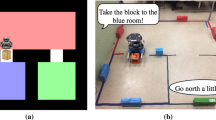Abstract
Our goal is to enable robots to understand or “ground” natural language instructions in the context of their perceived workspace. Contemporary models learn a probabilistic correspondence between input phrases and semantic concepts (or groundings) such as objects, regions or goals for robot motion derived from the robot’s world model. Crucially, these models assume a fixed and a priori known set of object types as well as phrases and train probable correspondences offline using static language-workspace corpora. Hence, model inference fails when an input command contains unknown phrases or references to novel object types that were not seen during the training. We introduce a probabilistic model that incorporates a notion of unknown groundings and learns a correspondence between an unknown phrase and an unknown object that cannot be classified into known visual categories. Further, we extend the model to “hypothesize” known or unknown object groundings in case the language utterance references an object that exists beyond the robot’s partial view of its workspace. When the grounding for an instruction is unknown or hypothetical, the robot performs exploratory actions to gather new observations and find the referenced objects beyond the current view. Once an unknown grounding is associated with percepts of a new object, the model is adapted and trained online using accrued visual-linguistic observations to reflect the new knowledge gained for interpreting future utterances. We evaluate the model quantitatively using a corpus from a user study and report experiments on a mobile platform in a workspace populated with objects from a standardized dataset. A video of the experimental demonstration is available at: https://youtu.be/XFLNdaUKgW0.
Authors thank support in part from the U.S. Army Research Laboratory under the RCTA program, the National Science Foundation. G. J. Stein acknowledges support by a NDSEG Graduate Fellowship.
Access this chapter
Tax calculation will be finalised at checkout
Purchases are for personal use only
Similar content being viewed by others
Notes
- 1.
If \(\lambda _i\) is a noun phrase, the corresponding grounding set \(\varGamma ^i\) contains the objects in the world (i.e., \(\varGamma ^O\)). If \(\lambda _i\) is a prepositional phrase (e.g., “front of a box”) then \(\varGamma ^i\) contains symbols denoting the discretized spatial regions (i.e., front, behind, left etc.) with respect to the objects under consideration (i.e., \(\varGamma ^{RO}\)). If \(\lambda _i\) is a verb phrase referring to the actions that the robot can take (e.g., “move towards a box”, “pick up the block”), then \(\varGamma ^i\) contains the set of constraints defined with respect to pairs of regions (e.g., picking a block can be implicitly expressed as a intersection constraint between the robot’s end-effector and the region occupied by the object).
References
Bosch, A., Zisserman, A., Munoz, X.: Image classification using random forests and ferns. In: IEEE 11th International Conference on Computer Vision, pp. 1–8. IEEE (2007)
Deits, R., Tellex, S., Thaker, P., Simeonov, D., Kollar, T., Roy, N.: Clarifying commands with information-theoretic human-robot dialog. J. Hum.-Robot. Interact. 2(2), 58–79 (2013)
Duvallet, F., Walter, M., Howard, T., Hemachandra, S., Oh, J.H., Teller, S., Roy, N., Stentz, A.T.: Inferring maps and behaviors from natural language instructions. In: International Symposium on Experimental Robotics (2014)
Fan, R.E., Chang, K.W., Hsieh, C.J., Wang, X.R., Lin, C.J.: Liblinear: a library for large linear classification. J. Mach. Learn. Res. 9,1871–1874 (2008)
Fong, T.W., Thorpe, C., Baur, C.: Robot, asker of questions. Robot. Auton. Syst. (2003)
Howard, T., Tellex, S., Roy, N.: A natural language planner interface for mobile manipulators. In: International Conference on Robotics and Automation (2014)
Liu, D.C., Nocedal, J.: On the limited memory BFGS method for large scale optimization. Math. Program. 45(1–3), 503–528 (1989)
Nyga, D., Beetz, M.: Reasoning about unmodelled concepts-incorporating class taxonomies in probabilistic relational models. arXiv:1504.05411 (2015)
Paul, R., Arkin, J., Roy, N., Howard, T.: Efficient grounding of abstract spatial concepts for natural language interaction with robot manipulators. In: Proceedings of Robotics Science and Systems (RSS), Ann Arbor, Michigan, USA (2016)
Ros, R., Lemaignan, S., Sisbot, E.A., Alami, R., Steinwender, J., Hamann, K., Warneken, F.: Which one? grounding the referent based on efficient human-robot interaction. In: 19th International Symposium in Robot and Human Interactive Communication, pp. 570–575 (2010)
Roy, N., Pineau, J., Thrun, S.: Spoken dialogue management using probabilistic reasoning. In: Proceedings of the 38th Annual Meeting of the Association for Computational Linguistics (ACL-2000), Hong Kong (2000)
Tellex, S., Kollar, T., Dickerson, S., Walter, M., Banerjee, A., Teller, S., Roy, N.: Understanding natural language commands for robotic navigation and mobile manipulation. In: National Conference on Artificial Intelligence (2011)
Vedaldi, A., Fulkerson, B.: Vlfeat: an open and portable library of computer vision algorithms. In: Proceedings of the 18th ACM International Conference on Multimedia, pp. 1469–1472. ACM (2010)
Zitnick, C.L., Dollár, P.: Edge boxes: locating object proposals from edges. In: European Conference on Computer Vision, pp. 391–405. Springer (2014)
Author information
Authors and Affiliations
Corresponding author
Editor information
Editors and Affiliations
Rights and permissions
Copyright information
© 2020 Springer Nature Switzerland AG
About this paper
Cite this paper
Tucker, M., Aksaray, D., Paul, R., Stein, G.J., Roy, N. (2020). Learning Unknown Groundings for Natural Language Interaction with Mobile Robots. In: Amato, N., Hager, G., Thomas, S., Torres-Torriti, M. (eds) Robotics Research. Springer Proceedings in Advanced Robotics, vol 10. Springer, Cham. https://doi.org/10.1007/978-3-030-28619-4_27
Download citation
DOI: https://doi.org/10.1007/978-3-030-28619-4_27
Published:
Publisher Name: Springer, Cham
Print ISBN: 978-3-030-28618-7
Online ISBN: 978-3-030-28619-4
eBook Packages: Intelligent Technologies and RoboticsIntelligent Technologies and Robotics (R0)




